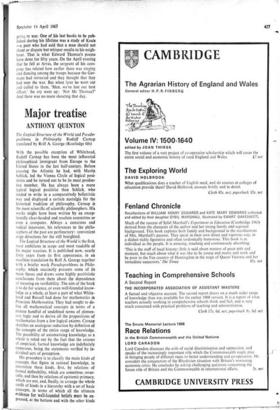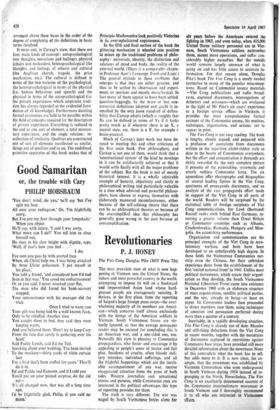Major treatise
ANTHONY QUINTON
With the possible exception of Whitehead, Rudolf Carnap has been the most influential philosophical immigrant from Europe to the United States in the last half-century. Before crossing the Atlantic he had, with Moritz Schlick, led the Vienna Circle of logical posi- tivists and he turned out to be its most produc- tive member. He has always been a more typical logical positivist than Schlick, who tended to write in a comparatively belletristic way and displayed a certain nostalgia for the historical tradition of philosophy. Carnap is the most scientific of scientific philosophers. His works might have been written by an excep- tionally clear-headed and resolute committee or even a computer. Always a conscious and radical innovator, his references to the philo- sophers of the past are perfunctory : convenient stage directions for the still benighted.
The Logical Structure of the World is the first, most ambitious in scope and most readable of his major treatises. It is published now, nearly forty years from its first appearance, in an excellent translation by Rolf A. George together with a briefer work Pseudoproblems in Philo- sophy, which succinctly presents some of its main theses and draws some highly positivistic conclusions from them about the dependence of meaning on verifiability. The aim of the book is to do for science, or even well-founded know- ledge as a whole, at least a part of what White- head and Russell had done for mathematics in Principia Mathematica. They had sought to de- fine all mathematical concepts in terms of a minute handful of undefined terms of elemen- tary logic and to derive all the propositions of mathematics from a few logical axioms. Carnap sketches an analogous reduction by definition of the concepts of the entire range of knowledge. The possibility of axiomatising knowledge as a whole is ruled out by the fact that the axioms of empirical, factual knowledge are indefinitely numerous, being the statements verified by in- dividual acts of perception.
His procedure is to classify the main kinds of concepts that figure in rational knowledge, to interrelate these kinds, first, by relations of formal definability, which are sometimes rever- sible, and then by relations of epistemic primacy, Which are not, and, finally, to arrange the whole outfit of kinds in a hierarchy with a set of basic concepts, in terms of which all the ultimate evidence for well-founded beliefs must be ex- pressed, at the bottom and with the other kinds
arranged above these bases in the order of the degree of complexity of the definitions in basic terms involved.
It turns out, in Carnap's view, that there are four main kinds of concept: autopsychological (my thoughts, sensations and feelings), physical (chairs and molecules), heteropsychological (the thoughts and feelings of others) and cultural (the Anglican church, tragedy, the price mechanism, etc.). The cultural is defined in terms of the two varieties of the psychological, the heteropsychological in terms of the physical (i.e. human behaviour and speech) and the physical in terms of the autopsychological (i.e. the private experiences which empiricist tradi- tion has always regarded as the evidential foun- dation of all knowledge). Furthermore dazzling formal economies are held to be possible within the field of concepts required for the description of private experience. Everything is reduced in the end to one sort of element, a total momen- tary experience, and the single relation: re- collection of similarity. Qualities are constructed out of sets of elements recollected as similar, things out of qualities and so on. The undefined, primitive apparatus of this book makes that of
Principia Mat hematica look positively Victorian in its over-upholstered copiousness.
In the fifth and final section of the book the glittering mechanism is wheeled into position to mince up the traditional problems of philo- sophy: universals, identity, the distinction and relations of mind and body, the reality of the external world. (There is a comparable chapter in Professor Ayer's Language, Truth and Logic.) The general attitude to these oroblems that emerges is that they are either genuine, and thus to be settled by observation and experi- ment, or spurious and merely metaphysical. In fact many of them appear to have been settled. question-beggingly, by the mare or less con- troversial definitions adopted and ..ioubt is in- tensified by the very loose standard of defina- bility that Carnap adopts (which is roughly that Xs can be defined in terms of Ys if it looks pretty much as if wherever there is an X, a mental state, say. there is a Y, for example a brain-process).
Much of Carnap's later work has been de- voted to meeting this and other criticisms of his first main book. Few philosophers, and Carnap is not one of them, would think that a 'constructional system' of the kind he develops in it can be satisfactorily achieved or that it would settle finally with all the major problems of the subject. But the book is not of merely historical interest. It is a wholly admirable example of honesty, objectivity and clarity in philosophical writing and particularly valuable in a time when admired and powerful philoso- phers have chosen to express themselves with elaborately mannered inconclusiveness, either because of the self-refuting theory that there can be no philosophical theories or because of the oversimplified ,idea that philosophy has generally gone wrong in the past because of oversimplification.































 Previous page
Previous page